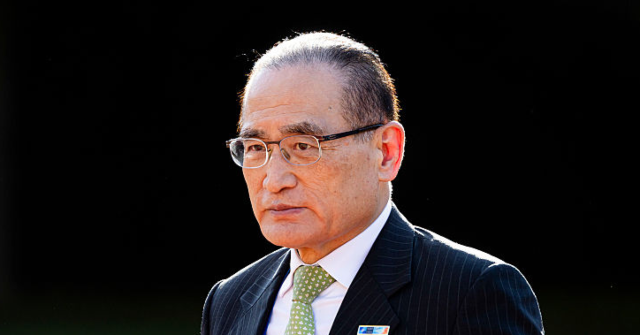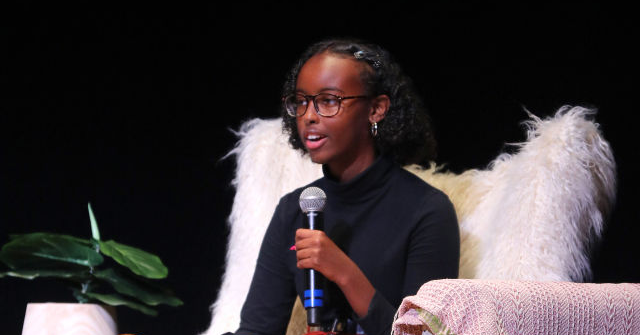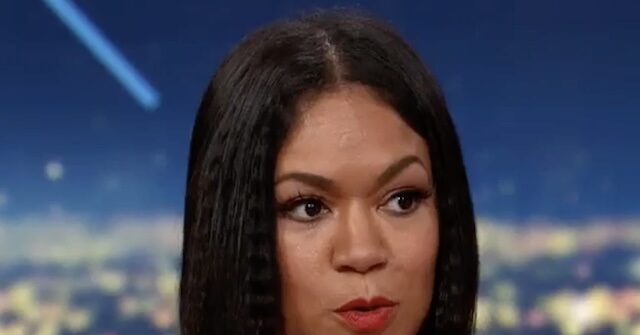 Edie Fake, The Free Clinic for Gender Affirming Care, 2024-25. Courtesy of the artist and Western Exhibitions
Edie Fake, The Free Clinic for Gender Affirming Care, 2024-25. Courtesy of the artist and Western ExhibitionsWhen you walk into the atrium entrance of Chicago’s MCA, the first thing you’ll see on the wall is a two-story illustration of a building façade pulsing with pastel colors. Blue and yellow windows, rainbow spectrum fringes, squares outlined with what look like strings of lights, rectangles, diamonds, ovals and triangles—an exultant architectural collage of exuberance that looks ready to leap up through the skylight, or swallow up the squiggly benches conveniently laid out before it for onlookers who want to sit and contemplate the spectacle.
This looming technicolor vision is a new mural by artist Edie Fake titled The Free Clinic for Gender Affirming Care. Fake, who lives in Twentynine Palms, California, was born in Evanston and was an active part of Chicago’s comics and arts scenes for years. His mural is the first salvo in “City In A Garden: Queer Art and Activism,” an exhibition opening July 5 that will explore the role of queer art and activism in Chicago from the 1980s to the present. The colorful façade beckons you into the future and into the past, reimagining reality with colorful queer spaces that welcome trans people and people of every gender.
“There’s been this ongoing, escalating assault on trans healthcare access, on just trans rights in general,” Fake told Observer. “I know how much it’s given to me to have access to gender affirming care.” He wants to believe that we can have a better world. “I feel like part of that is making this fantasy building—this impossible building that I want to be possible. I’m thinking about spaces that are necessary for queer community and seeing them beautifully and extravagantly in terms of bounty, instead of constant attack or scarcity.”
SEE ALSO: “The First Homosexuals” Is a Dazzlingly Overwhelming Chronicle of Queerness in Art
Fake created the mural first as a drawing and then turned it into a digital rendering. The piece was then printed out by MCA curators as wallpaper to be installed in the atrium. The high-end printing process meant Fake could use “a million thousand colors,” he said. That allowed him to create scintillating color gradations, so the “colors are changing from one thing to another.” That’s “a very trans aspect of my paintings,” Fake said, “and of this deign in particular.”
 Artist and transgender activist Edie Fake in front of one of his murals. Will Waldron/Albany Times Union via Getty Images
Artist and transgender activist Edie Fake in front of one of his murals. Will Waldron/Albany Times Union via Getty ImagesIt was important to Fake that it look like a building that could exist, but it also has “parts that look unusual or impossible or upside down.” One window looks like a diamond from across the room, but if you get closer and stare up at it from an angle, it reads like a standard square window that’s been tipped on its side. There are two towers of circular elements flanking the front entrance that could be columns in front of the door or flat designs painted on the door or rainbow phantasms. They hover between two and three and no dimensions, flickering on the edge of being real. “There’s a queerness to it,” Fake says. “It’s unfamiliar but also possible once you see it.”
The clinic’s most visible design element, in addition to its many colors, is the fact that it’s virtually all windows of different shapes and sizes. Fake was drawn to windows because he “wanted it to be a space that you contemplate going into, or that makes you curious to go into… I didn’t want it to be a building that felt like a fortress. I just wanted the design of this building to feel very open, very free.”
Fake’s work has always embraced an aesthetics of openness and freedom, though often in very different ways. He first gained acclaim for his 2000 comic series Gaylord Phoenix, published as a book in 2010. The comic is a magical colorful queer adventure story, with a protagonist of mixed and changing gender traveling, sliding through and being overwhelmed by shimmering landscapes of strange geometries while encountering sharp shadow versions of himself and sexy conglomerate wizards connected at the beard.
Fake has moved away from comics over the last decade and a half, though. “I remember hitting a point with comics where narratives started crumbling. I was like, I don’t know if I could make another comic that wouldn’t just be a repeat of comics I’d already made.”
Instead, he began creating architectural drawings, like his Memory Palaces series, which reimagines or invents the facades of queer Chicago nightclubs, bookstores, clinics and other venues. Fake said that some of the Memory Palaces works will be in “City In A Garden”—a natural fit since they are about Chicago’s queer community and queer history.
People don’t necessarily think of buildings or architecture as gendered or queer, but for Fake, imagining buildings is one way as an artist to address queer visibility and create queer spaces. “Reading about art movements, it’s not necessarily memoirs of a single person,” he said. “Instead, you read about an entire art community or scene. And I feel like drawing spaces gets to that. Like, this happened. Who was there? What does it mean for the present or the future?”
Right now the future for queer and trans people looks grim; the Trump administration is making a concerted effort to ban trans people from public life, and states like Florida and Oklahoma have been eager to embrace and extend federal discrimination. Blue states, including Illinois, have tried to pass protections for trans people and for gender affirming care. These and other efforts to defend trans people are welcome, but they can feel fragile in the face of the nationwide push towards hate.
In this context, Fake’s Free Clinic for Gender Affirming Care feels like an acknowledgement of Chicago’s past and present history as a space for queer acceptance and queer art. It also encourages everyone to imagine a future, and a present, in which the whole nation has room for more color, more shapes, more queerness and more love.












 English (US) ·
English (US) ·  French (CA) ·
French (CA) ·  French (FR) ·
French (FR) ·